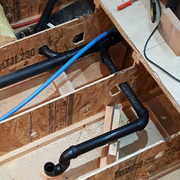|
Yawgmoth posted:I am learning so much from this thread! Most importantly, I have learned that if I ever own a home I should not touch a drat thing re: remodeling unless I talk to at least one coworker (most of my coworkers are architects/engineers). The other thing I learned in remodeling/home repair adventures is that "code" isn't a pinnacle of perfect workmanship or overkill, it's the bare minimum for safety and function. The other thing I've learned is that for many jobs the difference between a well-read amateur and a competent professional isn't always that the professional is going to get better final results, it's usually that they're going to do it a lot faster and probably with fewer screwups along the way (usually means wasted materials.) I got pretty good at tiling after doing 800 sq ft of it in my house, but a professional would have done it in like 2 or 3 days with a crew of 4 dudes rather than me doing it by myself on weekends/evenings over the course of a few months. The first parts of it were slow and required a lot of re-work, but by the end I was flying through it.
|
|
|
|

|
| # ? May 13, 2024 23:01 |
|
canyoneer posted:The other thing I learned in remodeling/home repair adventures is that "code" isn't a pinnacle of perfect workmanship or overkill, it's the bare minimum for safety and function. Agreed. I saw some homebuilt trusses one time that I thought wouldn't belong in a barn slated for demo, but was assured by the inspector they were up to code. Scabby rear end plates made of 1/2" plywood stapled at the joints. *OP scribbles furiously*
|
|
|
|
I always forget with I-beams. Why doesn't the center bit buckle directly under a large point load? Like, say, a bathtub?
|
|
|
|
Kommando posted:bEatmstrJ It would basically be blasphemy to have a bathroom that large without a tub. I would shoot my resale in the foot. Also, I like bathtubs, even though I never use them.
|
|
|
|
Arcturas posted:I always forget with I-beams. Why doesn't the center bit buckle directly under a large point load? Like, say, a bathtub? Like a stick snapping? or rotation? Rotation is stopped with bracing. Like "X"'s or the sub-floor sheathing alone. For snapping like a stick? A tub is spread over a number of joists. Each joist takes half of the load to the next joist (tributary area). I-beams are the shape they are because the most stress is at the "fibers" at the top and bottom. The middle web isn't doing a lot other than keeping it together. So that's why the "flange" is beefed up.
|
|
|
|
That's so cool. As someone who knows almost nothing about construction, I had always pictured I-beams being strong the other way (like an H), since it's like they're two beams next together, like regular floor joists or whatever. But that actually makes a lot of sense the the top and bottom of the I shape are resisting compression and tension that occurs as the result of a load.
|
|
|
|
Arcturas posted:I always forget with I-beams. Why doesn't the center bit buckle directly under a large point load? Like, say, a bathtub? The web is not supposed to really take loading. It's only purpose is to hold the two flanges together. The I-Beam is sized for a particular load so it doesn't have any deflection. If it deflects then it is undersized.
|
|
|
|
Learning this is awesome! Thanks everyone for explanations!
|
|
|
|
I was googling this after reading the above posts, and found a really comprehensive response about it on Quora https://www.quora.com/Structural-Engineering-Why-is-an-I-beam-shaped-the-way-it-is
|
|
|
|
This can't get enough love. Also this engineer-chat is surprisingly interesting.
|
|
|
|
bEatmstrJ posted:It would basically be blasphemy to have a bathroom that large without a tub. I would shoot my resale in the foot. Also, I like bathtubs, even though I never use them. So why does it need to be lowered, you keep teasing this without answering
|
|
|
|
SouthShoreSamurai posted:Also this engineer-chat is surprisingly interesting. If you can wade through all the poo poo-posts, it's amazing what you can learn on this forum. So it seems like this was answered before sort of, but hypothetically, if those joists were solid 4x10's or similar, first, are they not as strong as the I-Beams? Second, if I had notched those out instead, how would that have affected it?
|
|
|
|
bEatmstrJ posted:If you can wade through all the poo poo-posts, it's amazing what you can learn on this forum. The engineered joists generally span longer distances than you can buy dimensional lumber, dimensional lumber probably wasn't a hypothetical option.
|
|
|
|
bEatmstrJ posted:If you can wade through all the poo poo-posts, it's amazing what you can learn on this forum. Not as strong for equivalent cross-sectional area (ie looking at the end of the beam) or weight (given equal material). bEatmstrJ posted:Second, if I had notched those out instead, how would that have affected it? There's a mess of code about going through joists, but for solid joists it's basically 1) Try to go through solid joists at least 1-1/2" (e: iirc) from the top/bottom edges, as those edges are the most loaded (which makes sense when you think about it) 2) Keep your holes below a certain density of material being removed in a specific area to keep from weakening any one area too much For engineered beams like that, the rule is additionally: 1) only cut through the webbing in the middle and do not for any reason under any circumstances weaken the flanges at the top or bottom. Hubis fucked around with this message at 21:59 on Apr 7, 2017 |
|
|
|
bEatmstrJ posted:Second, if I had notched those out instead, how would that have affected it? Are you asking how badly
|
|
|
|
xwing posted:Not always true... over a load bearing wall in the middle of a house a beam would be in in tension at the top. Your statement is true for the simplest uniform loading supported at two ends. A cantilever is another case it wouldn't have the loading you describe. That's why beams are usually symmetrical in the y-axis because it works the same in both directions. I was not attempting to describe all loading situations, and even said as much. Just further explaining the situation going on here (and I always thought trying to picture beam internal forces was interesting).
|
|
|
|
Creating sharp edges with square notches to a beam like that also creates big stress concentrators. The stress can't "flow" around a sharp corner and local stresses shoot way up over what the average stresses might be. I forget the math off the top of my head, but here's a diagram: If you need to cut notches in structural members, try to round your corners!
|
|
|
|
brugroffil posted:Creating sharp edges with square notches to a beam like that also creates big stress concentrators. The stress can't "flow" around a sharp corner and local stresses shoot way up over what the average stresses might be. I forget the math off the top of my head, but here's a diagram: That reminds me of one of my favorite engineering factoids: https://www.youtube.com/watch?v=7rXGRPMD-GQ
|
|
|
|
brugroffil posted:Creating sharp edges with square notches to a beam like that also creates big stress concentrators. The stress can't "flow" around a sharp corner and local stresses shoot way up over what the average stresses might be. I forget the math off the top of my head, but here's a diagram: This instinctively looks and sounds like total hocus pocus, but it's exactly why the windows of metal-skinned aircraft have widely rounded sides. Because many moons ago someone looked at the common wisdom among shipbuilders that all hull-penetrating holes (portholes, anchor lines, etc) should be as close to perfectly round as possible and went "phht whatever old man, don't try to foist your baseless, unexamined cultural inertia on me. you're just mad that I'm disrupting your industry." and then some planes split in half and people died edit: Hubis posted:That reminds me of one of my favorite engineering factoids: gently caress MY BUTT
|
|
|
|
Arcturas posted:I always forget with I-beams. Why doesn't the center bit buckle directly under a large point load? Like, say, a bathtub? The manufacturers of the beam or joist usually choose the web thickness so that the load that would cause the web to buckle is higher than the material's capacity. The flange plates also prevent the web from rotating at its ends, so the effective length of the web is shorter than its full length, increasing its buckling load further. Generally, web buckling is only a concern with very tall, slender steel plate girders.
|
|
|
|
Apparently i have been lamely hoisted by my own gift avatar... sigh. didnt even properly redtext it.. a shameful goon.
|
|
|
|
sneakyfrog posted:Apparently i have been lamely hoisted by my own gift avatar... sigh. didnt even properly redtext it.. a shameful goon. Well, the salt in this thread should at least keep the moss at bay.
|
|
|
|
Effective-Disorder posted:Well, the salt in this thread should at least keep the moss at bay. *sigh* i just wish it were properly redtexted dammit folks attention to detail.
|
|
|
sneakyfrog posted:*sigh* i just wish it were properly redtexted dammit folks attention to detail. Apparently your DIY avatar gifter should have contracted out to a pro, then you wouldn't be in this predicament.
|
|
|
|
|
Hubis posted:Not as strong for equivalent cross-sectional area (ie looking at the end of the beam) or weight (given equal material). What does this mean?
|
|
|
|
Mr. Mambold posted:What does this mean? It's pretty straightforward. I-beams are stronger than solids when you compare the two in cross-sectional area (the X-section of the I-beam would equate to a much smaller dimension solid) and in weight (an equivalent-weight solid would be much weaker than an I-beam of the same weight). sharkytm fucked around with this message at 22:53 on Apr 7, 2017 |
|
|
|
just for clarification since y'all engies speak layman like poo poo, the I shape of the i beam is much better at distributing load, is lighter and in the case of long spans is much more affordable than an equivalent piece of solid material even assuming you could get one in an extended span for larger homes, correct?
|
|
|
|
It's the same concept as putting a fuller in the blade of a sword. You are making a blade that is stronger for its finished weight than a blade without a fuller. Since I'm familiar with that, I'm surprised I didn't think about how I-beams work sooner.
|
|
|
|
Mr. Mambold posted:What does this mean? bunch of poo poo that make no kind of useful comparison to anyone but an engineer "hey I need to build a floor, what cross-sectional area of dimensional lumber does the code specify for joists? how many pounds of wood products should I buy to frame the roof?" Cactus Ghost fucked around with this message at 22:52 on Apr 7, 2017 |
|
|
|
sneakyfrog posted:just for clarification since y'all engies speak layman like poo poo, the I shape of the i beam is much better at distributing load, is lighter and in the case of long spans is much more affordable than an equivalent piece of solid material even assuming you could get one in an extended span for larger homes, correct? A solid beam only really takes load on the edges so an i beam saves weight by being as close to all edge as possible while still being one piece.
|
|
|
|
dis astranagant posted:A solid beam only really takes load on the edges so an i beam saves weight by being as close to all edge as possible while still being one piece. Snak posted:It's the same concept as putting a fuller in the blade of a sword. You are making a blade that is stronger for its finished weight than a blade without a fuller. in between these two posts i stated getting a feel for the idea thanks folks
|
|
|
|
This is why the building code exists, you don't need to be an engineer to read it. You draw up your room, you then see how long of joists you need and look it up on a span table. Your room is X meters wide? Ok you need 2x10 SPF minimum for typical use. Very simple, any carpenter or DIY type can understand that sort of thing. A good contractor will know to go over that in some area, he'll know if you do the absolute minimum there might be some bounce in the middle of larger rooms, or maybe you want to adjust the joist spacing under the tub. A typical house can be built without a full on structural engineer, those generally only get involved when you try to do something not covered by the code, or you've hosed something up big time. In this case I'd be really curious to see the plans for the house. How was the bathroom build? What's the span on those engineered beams? What are they bearing on? What's below ? That sort of thing. Where I live engineered beams are generally only used in more extreme situations, like maybe spanning some rooms above a "great room" or something below where they want a huge cavernous area. If it can be helped, normal dimensional lumber is used for everything. I did see one developer put up a bunch of over-sized mcmansion style houses that all had "great rooms" because that's a thing suburban folks just need because I mean how can you even watch TV in a room smaller than 20x20??? Well someone hosed up their span tables big time because halfway through framing they ripped out the same chunk of the house on every house. Next thing I know there's a STEEL beam going in, bearing on a fat wooden post on one side and a steal post on the other (this was wierd too) making a big L shape. That must have cost a lot and was probably due to some calculation being a tiny bit off. Baronjutter fucked around with this message at 22:57 on Apr 7, 2017 |
|
|
|
Snak posted:It's the same concept as putting a fuller in the blade of a sword. You are making a blade that is stronger for its finished weight than a blade without a fuller. How do swords work? What is a fuller? edit: i tried putting a lame wrong type of ram joke here
|
|
|
|
got any sevens posted:How do swords work? What is a fuller? commonly known as a "blood groove" it reduces weight and concentrates the weight and force towards the edges so its lighter and easier to maneuver but thicker and stronger to resist a cross blade or actual hits and wear on the edges.
|
|
|
|
sharkytm posted:It's pretty straightforward. I-beams are stronger than solids when you compare the two in cross-sectional area (the X-section of the I-beam would equate to a much smaller dimension solid) and in weight (an equivalent-weight solid would be much weaker than an I-beam of the same weight). Well I kinda got the last part of that, but where OP was asking about a 4x10 and it looked like that post was saying the I-beam was stronger, I lost it.
|
|
|
|
Hubis posted:That reminds me of one of my favorite engineering factoids: There's no denying that this thread has made me quite a bit smarter already. In relevant news, my first contractor just left. I pointed out every flaw I've made since I started and gave him a list of them so he can laugh about it later. He said he's definitely seen worse problems and said he's seen engineers recommend sistering 2x4's the whole length of the joist to fix them. I'm not taking his word as gold or anything but we talked about a lot of things and he had a pretty positive attitude. Definitely got a good vibe from him. Some notes from our discussion: - Engineer definitely needed - Inspectors will be involved - The studs I notched out are probably inconsequential (the rafters in newer houses typically run from exterior wall to wall and don't rely on interior walls in between. He was almost certain it wasn't a load bearing wall and thus the notches aren't really an issue. He was more concerned that I covered the pipe with stud plates, which I did. - The medicine cabinet cutout was a non-issue for the same reason - The wall I built for the shower might need to be flipped (double plate goes on top, not bottom), but nailing through the drywall was not an issue. Though some bracing will need to be added at the top for earthquake safety. And the weight of the tile on the new wall will need to be factored into the joists, which I didn't really consider. - The venting of the double vanities were discussed and we didn't really come to a resolution, but thats on the table - Bathtub plumbing and venting seemed fine even though it will likely have to be redone for the joists - Most of the subfloor will need to come up, pretty obvious - He took several pictures and measurements and I gave him my cheat sheet of what I would like done All in all i'm pretty happy with the guy so far. Several more appointments upcoming, but we'll see what happens as things progress. bEatmstrJ fucked around with this message at 23:42 on Apr 7, 2017 |
|
|
|
got any sevens posted:How do swords work? What is a fuller? It's the same principle as an I-beam...
|
|
|
|
look at this guy you should get a picture of the engineer holding a sign saying "Its good Kid, I'm unfucking it"
|
|
|
|
sneakyfrog posted:just for clarification since y'all engies speak layman like poo poo, the I shape of the i beam is much better at distributing load, is lighter and in the case of long spans is much more affordable than an equivalent piece of solid material even assuming you could get one in an extended span for larger homes, correct? When you bend a beam, it forms an arc shape, such that it's in compression (crushed) at the top and tension (stretched) at the bottom. The material at the very center of the beam doesn't deform in bending, so it's not carrying any load. The further away the material is from the center, the more it contributes to resisting bending. A flanged beam like a steel wide-flange or a wood I-joist has most of its material at the very top and bottom of the beam, spread as far apart as possible. This minimizes the area that isn't meaningfully contributing bending capacity to the beam and maximizes the contribution of the material. In the case of home construction, engineered lumber costs more per foot than regular lumber, but you can use less of it. However, they do have some drawbacks -- the biggest of which is that it's really easy to completely ruin them and reduce their capacity significantly by damaging their flanges...
|
|
|
|

|
| # ? May 13, 2024 23:01 |
|
The Chairman posted:When you bend a beam, it forms an arc shape, such that it's in compression (crushed) at the top and tension (stretched) at the bottom. The material at the very center of the beam doesn't deform in bending, so it's not carrying any load. The further away the material is from the center, the more it contributes to resisting bending. i see what you did there and thank you
|
|
|





































